Anatomical Total Shoulder Arthroplasty (Total Shoulder Replacement Surgery)
If You Have the Following Symptoms, You May Be Suffering from Osteoarthritis of the Shoulder
【Symptoms】
- Limited shoulder movement with grinding noises.
- Minimal pain when the shoulder is not moved, but intense pain upon movement.
- Difficulty raising the arm smoothly (indicative of severe deformation). The shoulder cannot be raised to the side.
If you have these symptoms, it is possible that the shoulder bone is deformed as shown in the illustration. The diagram below shows a normal shoulder on the left and a deformed shoulder joint (osteoarthritis of the shoulder) on the right.
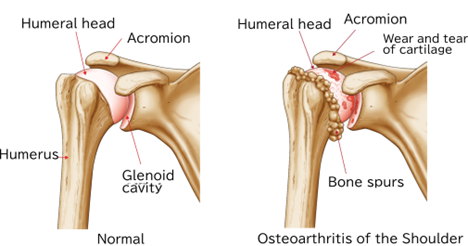
Differences Between Normal and Osteoarthritic Shoulder as Illustrated
The difference between a normal shoulder and one affected by osteoarthritis lies in the wearing down of the cartilage of the humeral head and the cartilage of the glenoid cavity (the socket part of the shoulder blade). Additionally, abnormal bone spurs develop around the humeral head. The exact mechanism of how these bone spurs form is not fully understood.
【Treatment plan】
【If the Pain is Severe】
In cases of severe pain, the first choice of treatment is usually conservative therapy. This often involves injecting medication into the joint to reduce inflammation, combined with long-term rest, which frequently alleviates shoulder pain.
【The Pain is Not Severe, but it Hurts When Moving, Movement is Limited, Unable to Raise Arm to the Side】
In cases of mild osteoarthritis of the shoulder, exercise therapy can help to expand the range of motion. Therefore, exercise therapy is effective for mild conditions. However, if the cartilage wear is severe or there are significant bone spurs, it is often difficult to improve the range of motion and reduce pain during movement with exercise therapy alone.
【Artificial Joint Replacement Surgery】
Artificial joint replacement surgery involves inserting the following instruments into the scapula and humerus of the shoulder, as shown in the illustration. Please refer to the illustration. For the deformed humerus, a metal ball (head) and rod (stem) are inserted into the humerus. A plastic socket (illustration right, glenoid component) is placed into the glenoid cavity of the scapula. The plastic socket is typically fixed in place with an adhesive called bone cement.
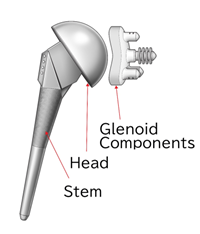
The diagram below shows the artificial joint inserted into the humerus and scapula. The stem and head are connected.
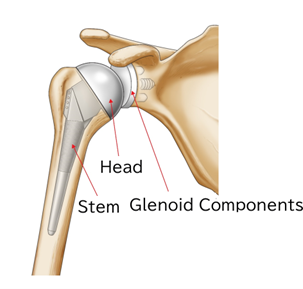
The diagram below shows the plastic socket (plastic component, referred to by doctors as the glenoid component) inserted into the glenoid cavity of the scapula.

【Normal, Preoperative and Postoperative X-rays for Total Shoulder Arthroplasty】
Normal:
The humeral head has a rounded shape, and there is a space between the glenoid cavity and the humeral head.
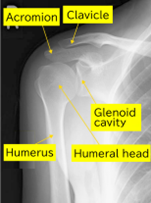
Preoperative X-ray:
Significant deformation of the humerus is observed. The round shape of the humeral head is lost.
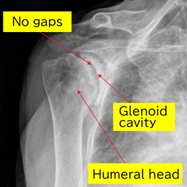
X-ray after surgery

【Rehabilitation After Total Shoulder Replacement Surgery】
Rehabilitation varies between facilities, but generally, a brace will be worn for several weeks. Gradual rehabilitation will follow. Based on my experience observing clinical settings in the United States, some people can raise their arm to head height within three months. However, the timeline and extent of improved range of motion vary greatly from person to person. Therefore, it is recommended to consult with your primary physician.
【How to raise your shoulders after rehabilitation】
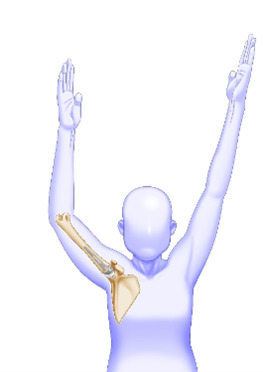
The illustration shows the average shoulder movement.
Please understand that it is difficult to achieve the same range of motion as the healthy side.
【Prognosis After Total Shoulder Replacement Surgery】
Here is a general guideline for the prognosis and course after total shoulder replacement surgery. If the progress is good, the shoulder movement post-rehabilitation will be sustained as shown in the illustration. In the past, the prognosis for total shoulder replacement surgery was not considered very good. This is because the plastic socket mentioned above would loosen within a few years, meaning the plastic would shift or detach from the scapula, causing the pain to recur. However, recent medical advancements have reduced the frequency of this loosening. This is based on reports from facilities where artificial joints are commonly performed abroad (such as the United States and France). Currently, there are no reports of long-term treatment results (over 10 years) for Japanese patients who have undergone total shoulder replacement surgery. Therefore, it is recommended to discuss with your primary physician how long the shoulder artificial joint will last.
【How Much Weight Can Be Lifted and Whether Sports Can Be Played After Total Shoulder Replacement Surgery】
There is no unified opinion on how much weight can be lifted or the level of activity in high-activity sports after surgery. My mentor, Dr. Williams, advised patients not to lift more than 10kg with both hands. There were also patients who played golf after total shoulder replacement surgery under Dr. Williams' care. However, the ability to engage in sports like golf depends on the patient's muscle strength and other factors, so it varies from person to person. Therefore, it is recommended to consult with your primary physician about the level of physical activity and the amount of weight that can be safely lifted.
【Representative Examples of Complications Specific to Total Shoulder Replacement Surgery】
We will talk about typical examples of complications that can occur during and after total joint replacement surgery.
- Infection and Suppuration
Artificial joints are foreign objects to the human body. Infections can occur early after surgery or even when the recovery is going well if the body's immune system weakens, allowing bacteria to invade around the artificial joint and cause suppuration. Symptoms such as swelling of the shoulder, persistent fever, or sudden intense pain may indicate an infection. During surgery, doctors administer intravenous antibiotics and perform intraoperative washing to prevent bacterial colonization. However, infection is still a potential complication. - Nerve Damage
In total shoulder replacement surgery, muscles are moved aside, and the ligaments of the joint are cut to accurately place the prosthetic components. During these procedures, temporary nerve damage (such as hand numbness or difficulty bending the elbow for a few days) may occur due to the traction on the arm. - Loosening of the Artificial Joint
As mentioned above, artificial joints may loosen over time, causing them to wobble. This is similar to how dental implants or fillings can wear down. With use, the components of the artificial joint can experience wear and tear.
【Measures to Address Complications After Total Shoulder Replacement Surgery】
- Infection, Suppuration, and Loosening of the Artificial Joint
Depending on the severity, a second surgery may be required. For infections, intravenous antibiotics and surgical washing of the body are used. However, in some cases, the infection may not be controlled. If the infection is severe, it may be necessary to remove the artificial joint entirely. In cases of loosening of the artificial joint, a second surgery may also be required. In such surgeries, a common procedure is to replace the plastic socket in the glenoid cavity (the socket part of the scapula), which results in a reduction of bone. During the second surgery, it is often very difficult to replace the plastic socket again. Therefore, most often, only the metal ball and rod (head and stem) in the humerus are replaced. However, second surgeries are very complex procedures and should be discussed with your primary physician.
【Summary of Osteoarthritis of the Shoulder】
- Total shoulder replacement surgery is an effective method for improving symptoms in advanced osteoarthritis of the humerus and scapula."
- However, several potential complications may arise, so it is important to thoroughly consult with your primary physician before deciding on surgery.
- Even if the surgery goes well and rehabilitation is completed, it is difficult to achieve the same level of function as the healthy side.
Outpatient Reception & Consultation Hours
| Business Hours | 月 | 火 | 水 | 木 | 金 | 土 | 日 |
|---|---|---|---|---|---|---|---|
| 13:00~17:00 | ● | ● | ー | ● | ● | ー | ● |
| 18:00~20:00 | ● | ● | ー | ● | ● | ー | ● |
【Closed Days】 Wednesday, Saturday, and Public Holidays.
※translates to "Reception ends 30 minutes before the end of consultation hours."
